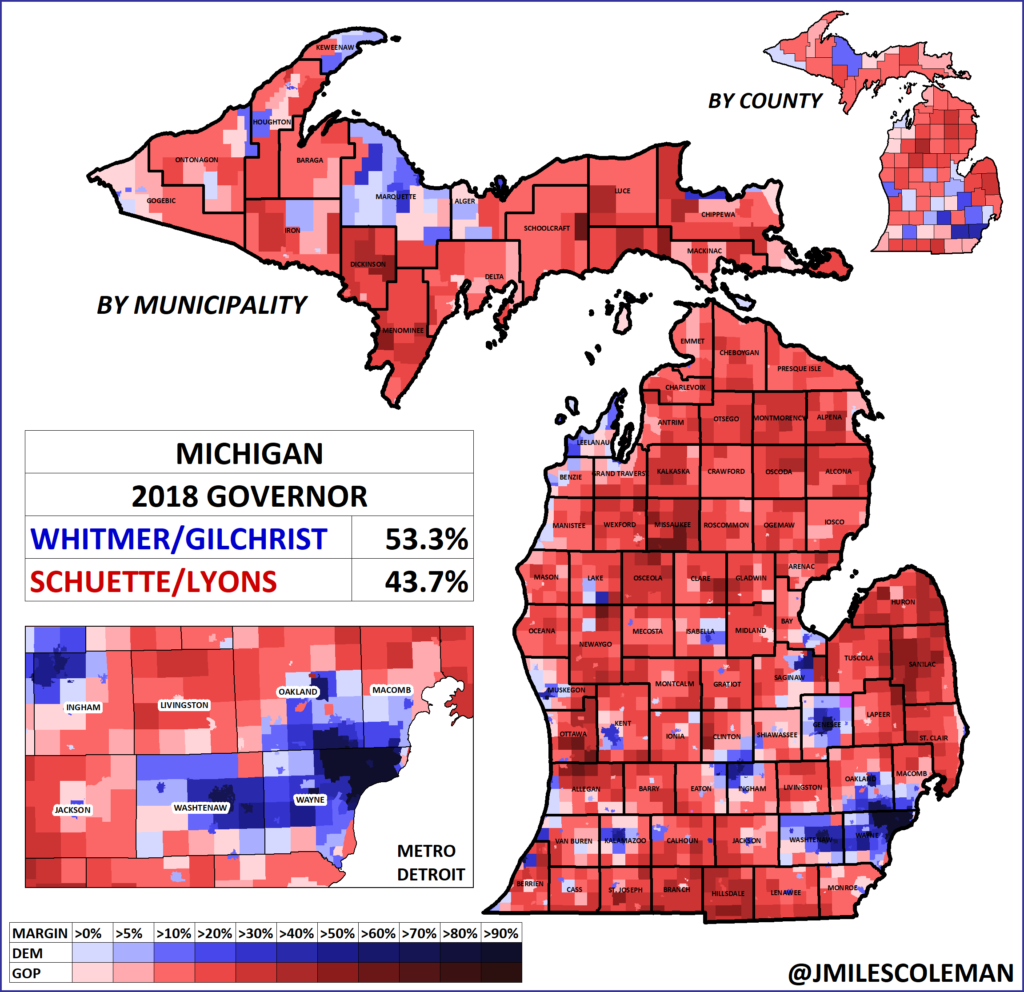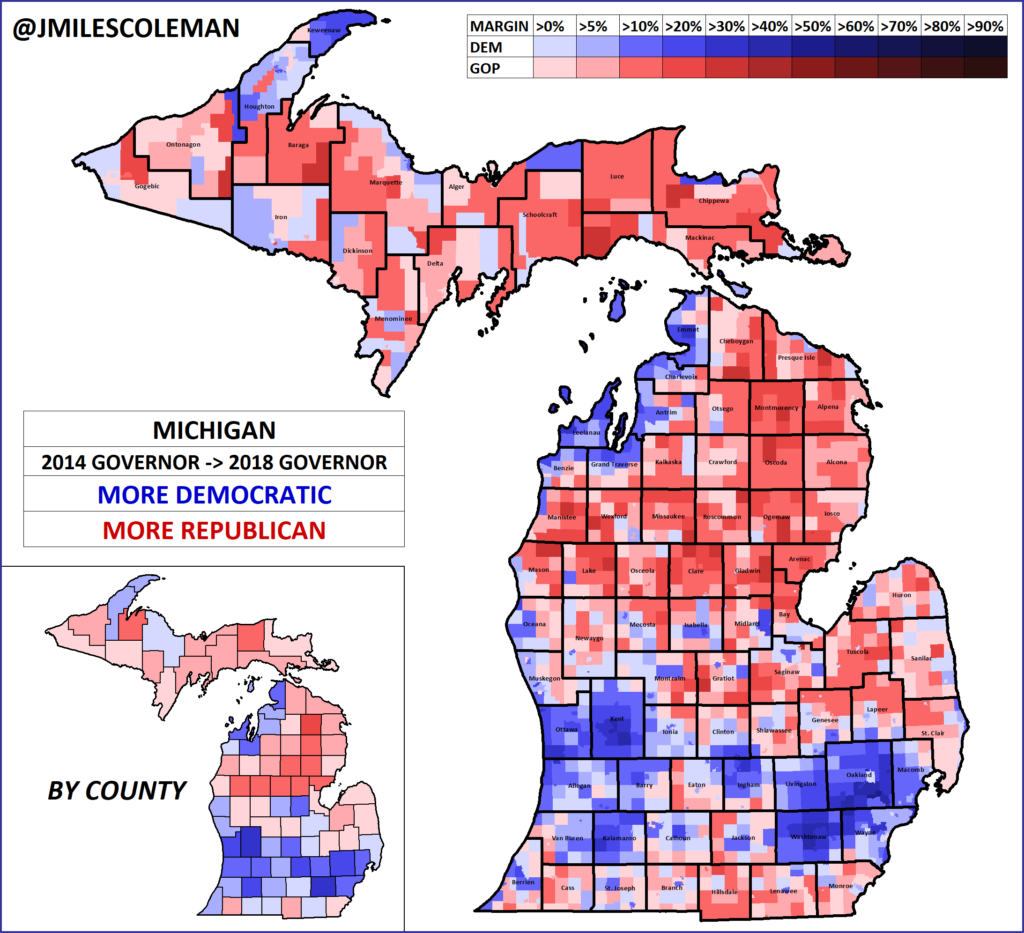After a lackluster showing throughout the region in 2014, Democrats picked up a trio of Governorships in the Great Lakes states in 2018. Two of these states (Illinois & Wisconsin) were gained by defeating Republican incumbents while one, Michigan, was an open contest.
Long mentioned as a candidate for statewide office, Democrats ran Gretchen Whitmer for Governor. Previously serving as a state legislator representing Lansing, Whitmer teamed up with former Detroit city administrator Garlin Gilchrist on a “fix the roads!” platform. The GOP nominated State Attorney General Bill Schuette, who chose Kent County Clerk Lisa Lyons as his running mate.
Schuette received the President’s endorsement in the primary, and had a stridently pro-Trump campaign throughout. While the President narrowly carried Michigan in 2016, by the midterms, his popularity was hovering in the low-40s. Despite the Wolverine State’s purple tendencies, the national environment, coupled with her superior campaign effort, led to a nearly 10% win for Whitmer:
As the map implies, despite the overall outcome, the urban/rural divide in 2018 was salient. As usual, metro Detroit featured all shades of blue, with the terrain getting redder as one moves north. Whitmer dominated in her home county, Ingham (Lansing), with 67% while Schuette won his home Midland County by a less commanding 55/42.
Macomb County, to the northeast of Detroit, is famous for its ‘Reagan Democrats’; it went to Trump by 11% in 2016, but gave Whitmer 50.4%.
In something of a break from past races, Washtenaw (Ann Arbor), not Wayne (Detroit), was the most Democratic county in the state. Washtenaw is a college county (housing the University of Michigan) while Wayne has a higher black and blue collar white population (the traditional linchpins of the Democratic base in the midwest).
Whitmer’s win was especially satisfying to Democrats because they suffered a close but clear loss in 2014. Elected during the Great Recession in 2010, Gov. Rick Snyder (R) won his first term by a wide 18%. His reelection in 2014 was more competitive, but he defeated former Congressman Mark Schauer (D) by 4%.
Compared to Schauer’s 2014 performance, Whitmer made massive gains in suburban counties, while much of the less populous north drifted GOP:
One of the counties that most stands out here is Kent, in western Michigan. Home to the city of Grand Rapids, it’s one of Michigan’s faster-growing counties. In his Congressional years, the late President Gerald Ford (R) represented this area; statewide Republicans would typically carry it easily in contested races. The 2014 result was par for the course; Snyder took 51% overall, but cleared 60% in Kent. Last year, it gave Whitmer a 4%, and voted Democratic in all but one statewide race.
While Washentaw County was the most Democratic county in 2018, Snyder was from there and took 42% in 2014 – a strong showing for a Republican. Snyder’s home county bonus may have inflated its 32% swing to Whitmer in 2018.
One interesting county that went against the grain was Genesee, which contains Flint: despite the backlash the Snyder administration received from the (ongoing) Flint water crisis, it actually got more Republican.
Looking further back, Whitmer’s 9.6% margin in 2018 was almost identical to President Obama’s 9.5% margin, when he carried the state in 2012. Not surprisingly, when comparing the two races, many familiar themes emerge:
Of the ten most vote-rich municipalities, Whitmer only performed worse than Obama in two: she ran 4.8% behind in Detroit, perhaps a function of lower turnout in midterm years, and she did slightly worse in Warren, the largest city in Macomb County. Some of Whitmer’s biggest improvements came in Grand Rapids (11.3%), Ann Arbor (13.2%), and Livonia (11.3%).
Aside from the larger southern merto areas, in the northwest, the Grand Traverse area features a contiguous swath of blue hugging the coast. While Grand Traverse County still voted for Schuette, his 1.6% margin was much weaker than Romney’s 11.8%.
Looking at towns that changed hands between the elections, Schuette flipped 139 Obama towns, while 61 went from Romney to Whitmer:
Many Romney -> Whitmer towns were in Oakland and Washtenaw counties, as well as around Lansing. These towns are generally wealthier and their voters are likelier to hold college degrees; they could support a mainstream Republican like Romney, but were turned off by Schuette’s Trump-esque campaign.
Conversely, most of the Obama -> Schuette towns are rural. Shiawassee County, which sits in between the larger counties of Ingham (Lansing) and Genesee (Flint), encapsulates this well. The home county of the late New York Governor and Presidential candidate Tom Dewey (R), it’s heavily blue collar and has been receptive to a Trumpier GOP. Whitmer held its largest town, Owosso, but couldn’t replicate Obama’s performance in the rural towns surrounding it.
Finally, while their percentage margins were comparable, Whitmer received 298,000 fewer raw votes than Obama. A drop like this makes sense, considering 2018 was a non-Presidential year, but I was curious to see where the difference were. In this map, Whitmer received more votes than Obama in blue towns, and fewer in red towns:
The overall theme was that Obama received more votes in the urban cores and rurals while Whitmer fared better in the suburbs. Of the 298,000 more votes Obama received, 1/3 of that (just over 99,000) came from Detroit alone.
Oakland County seems to be a good microcosm of the broader trends. It cast about the same number of votes for both candidates (349K for Obama, 347K for Whitmer) but had divergent internal trends. In the middle of the county, the city of Pontiac (heavily black) is dark red, but some of the whiter & wealthier neighboring townships form a bright blue ring around it.
Ingham County follows a similar pattern. Turnout was down in Lansing proper – the red in the northwestern part of the county – but the suburban counties touching it are blue. Clinton County, to the north, gave Whitmer more votes than Obama, and flipped to her after supporting Romney in 2012. The strip of blue towns running along its southern border suggests the county’s electoral character is increasingly being influenced by Lansing.
Some good news for the GOP may be that Whitmer got fewer votes than Obama in every Macomb County town. Further, except for some wealthier towns on its northern extremes, Whitmer ran behind Obama’s totals in most of Wayne County, even outside Detroit proper.
Livingston County, on western side of Oakland, is a reliably Republican county, though gave Whitmer more votes. I have to wonder if this is more due to the competitive MI-08 race there, or if the county is just becoming more influenced by the bluer counties around it.
Whitmer’s win showed that, if a Democrat can carry the state in 2020, their map will likely look a lot more like her’s than Obama’s. While most of the state’s geographic area has gotten redder, Democrats have increasingly leaned on educated and wealthier voters in their traditional strongholds, like metro Detroit, while bringing new counties, like Kent, into their coalition.
For the next post, we’ll break Senator Debbie Stabenow’s 2018 race down by township, and see what that could mean for the 2020 Senate race.




